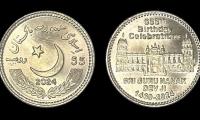LAHORE: The agreement that traders signed with the government has pushed us back 20 years, as they reached a similar agreement with Ishaq Dar in 1999. This time they gained advantage of taking the non-documentation limit from Rs50 to Rs100 million.
The traders who are required to pay turnover tax of 0.5 percent are exempt from documentation. Like before, the traders would not provide documents to prove their annual turnover, and whatever turnover they declare will be accepted by the tax collector.
Dr Hafeez Shiekh has already pointed out that out of 3.5 million traders only 0.39 million deposit tax, the rest pay no tax at all. What he did not mention was the fact that even those that pay turnover tax grossly concealed their actual turnover. The 0.5 percent turnover tax means that a traders with an annual turnover of Rs10 million would have to pay Rs50,000 as tax. The traders having turnover of Rs100 million would have to pay Rs500,000 as turnover tax. These taxes look high, but the traders accepted even a higher percentage of one percent in the past because the turnover would be determined by them and not the tax collector.
Now, if we look at economics of even a small neighbourhood store, we will find that the profit margins on all branded items are very low ranging from one to two percent on edible oil to 5 percent on biscuits, toothpastes, shampoos and soaps. On unbranded toffees and sweets they earn higher retail profit. They earn around 10 percent on items like pulses, spices and sugar.
The shopkeeper has to pay the rent and bear expensive commercial power tariff. The average profit from sales of all these items would not be more than 5 percent. Commercial viability of even this small shop requires an average daily sales of Rs40,000. His net sales would be Rs1.2 million in a month and his gross profit would be Rs60,000.
After deducting the shop rent and power bill, the shopkeeper would be left with Rs40,000. His turnover tax of 0.5 percent on Rs1.2 million turnover would be Rs6,000 or ten percent of his gross income. The small shopkeeper would have to manage his family budget in Rs34,000 only.
This category of shopkeepers would first try to remain out of the tax net, but if they are forced to pay the turnover tax they would reduce their official turnover to Rs30,000 per month or a daily turnover of Rs10,000.
Even a layman knows that doing business at this low turnover is not viable. But the tax collector would not be able to challenge him because the trader is not required to provide any documents to prove his sales. In fact, the tax collector would not even know what the trader has purchased. Each category shopkeeper would correspondingly lower the turnover and for sure no one would be depositing amounts like Rs500,000 or Rs40,000 relating to annual turnover of Rs100 or Rs80 million. So the system works as it did in the last few decades. The government would not be able to collect much from the traders under the currently concluded deal.
As far as the condition of CNIC on purchases of above Rs50,000 is concern it would worry only those who buy a single item that carries a price of Rs50,000 or more. Products like larger TV sets, refrigerators, air conditioners would fall under this category. Vehicles and properties sales and purchase would require the CNIC. The slowdown in car sales and property is partly because of this condition. For all other items with a price tag below Rs50,000 the traders have openly chalked out their strategy of making purchases below the Rs50,000 threshold to avoid the CNIC condition. Most of the traders would thus be able to avoid documentation.
The FBR revenues would also get a hit after this agreement because the turnover tax up to Rs100 million as the tax rate has been reduced from 1.5 percent to 0.5 percent.
Moreover, the limit of power bill for sales tax registration has been enhanced from Rs600,000/annum to Rs1.2 million/annum. The FBR chairman has stated at the lower limit of Rs50,000/month or Rs600,000/year a revenue of Rs3.8 billion was collected up till now. This revenue would be less than half in the next three quarters.
The Turkish Consul General, Cemal Sangu paid a visit to Dawlance’s Head Office in Karachi, where he met the CEO...
This representational image shows Gold bars. — AFP/FileKARACHI: Gold prices rose by Rs3,700 per tola on Thursday in...
PCJCCI logo can be seen on a computer screen, image taken on November 5, 2024. — TheNews/AquibAliLAHORE: The...
Participants listen to speeches during the United Nations Climate Change Conference in Baku on November 13, 2024. —...
Shipping containers are unloaded from ships at a container terminal at the Port of Long Beach-Port of Los Angeles...
National Assembly’s Standing Committee members and IMC officials posing for a photo. — IMC website/FileKARACHI:...







